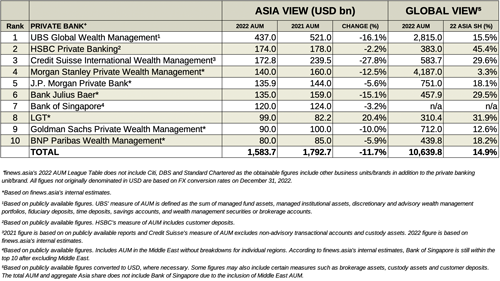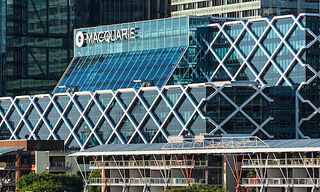Asia's private banking industry faced a double whammy of persistent Covid curbs and a multi-asset class market downturn in 2022 leading to a second consecutive year of asset decline. finews.asia reviews the damage with the release of its annual Private Banking AUM League Table.
The total assets under management (AUM) at Asia’s top 10 largest private banks fell $209 billion to under $1.6 trillion last year, according to finews.asia’s 2022 Private Banking AUM League Table, marking the second consecutive year of decline.
In addition to continued Covid-linked restrictions in the region limiting client acquisitions, the 11.7 percent AUM drop was also attributable to a rare phenomenon unseen in decades: the simultaneous downturn of stock and bond prices.
The fundamental basis underpinning traditional 60/40 portfolios – the negative correlation between the equity and fixed-income asset class – was challenged, contributing to negative performance and mass de-risking across the board.
Swiss Decline
Headlining the decline is Credit Suisse which saw $66.7 billion of AUM in Asia wiped out last year, according to finews.asia data. But the soon-to-be-defunct lender is not alone in feeling the pressure in Switzerland with local rivals UBS and Julius Baer also experiencing outflows.
UBS Global Wealth Management’s (GWM) Asia unit saw $84 billion in AUM lost. While Julius Baer recorded net inflows in the second half of 2022, it only partly offset outflows from the first half, due particularly to de-risking by «a number of large clients», resulting in an estimated $24 billion decrease in AUM for the full year.
US Dip
American private banks also posted lower AUM in 2022, albeit to a lesser extent compared to their Swiss counterparts.
The wealth arms of Morgan Stanley, Goldman Sachs and J.P. Morgan Private Bank saw estimated net outflows of $20 billion, $10 billion and $9 billion in Asia, respectively.
Asian Resilience
In contrast, the private banking arms of Asia-focused financial groups demonstrated resilience in maintaining their client asset bases and showcased their local advantage.
HSBC Global Private Bank ($4 billion decrease) and Bank of Singapore ($4 billion decrease) both registered only minor reductions in AUM in Asia.
Outlier in Liechtenstein
While the rest of the industry registered lower AUM, LGT was the lone grower with a 20.4 percent surge to $99 billion.
The Liechtenstein-based pure-play was 2022’s standout private bank of the year in Asia as it managed to buck the trend with acquisitions, including Australia's Crestone in May 2022 and India’s Validus Wealth in August 2022. The two additions resulted in 16.6 billion Swiss francs ($17.9 billion as of end-2022) of new money, accounting for the majority of net inflows for the overall group.
Optimistic Outlook
Despite the overall decline in AUM, private banks in Asia are expected to see a recovery in 2023. China’s reopening, rebounding economic activity in the region and a peaking US interest rate cycle will act as tailwinds.
Some private banks that have reported their first quarter results are already seeing improvements. UBS GWM saw a $19 billion AUM quarter-on-quarter increase in Asia, including a $7 billion boost in fee-generating assets. In the same period, Citi Private Bank (not included in finews.asia's league table) posted a 20 percent year-on-year increase in net new assets in the region while more than doubling client acquisitions.
Impact of Credit Suisse Takeover
Another noteworthy source of new assets will be from the impact of the UBS takeover of Credit Suisse which, by one Citi estimate, could result in up to 162 billion Swiss francs of outflows worldwide. Julius Baer is forecasted to be the top beneficiary, capturing an estimated 10 billion francs in client assets.
See finews.asia’s 2022 Private Banking AUM League Table below.
(Click to enlarge)




























